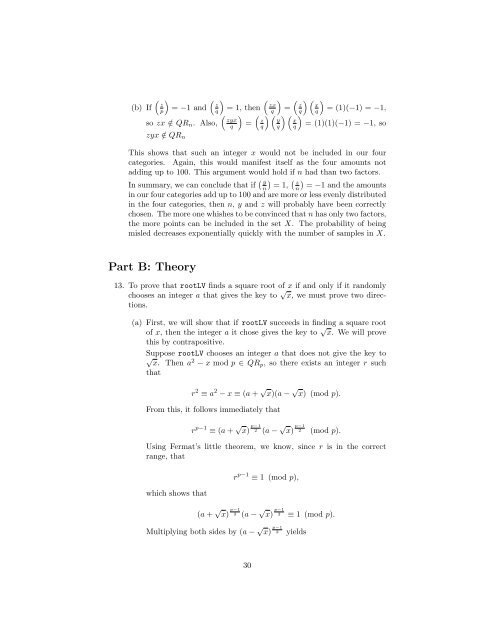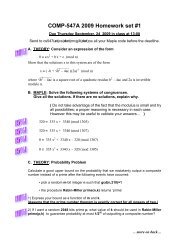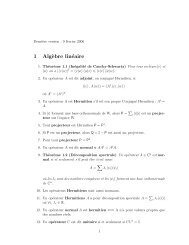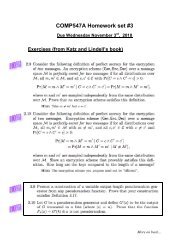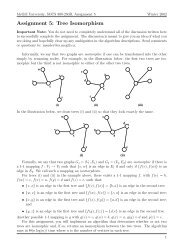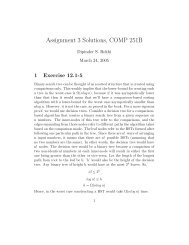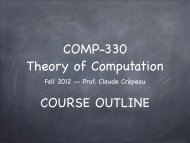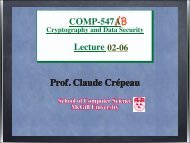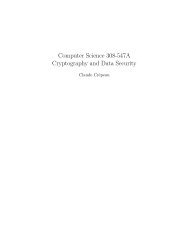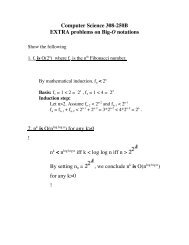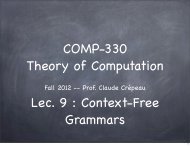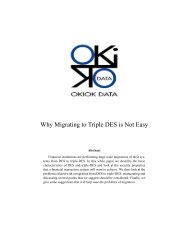COMP 547: Assignment 1 Solutions
COMP 547: Assignment 1 Solutions
COMP 547: Assignment 1 Solutions
You also want an ePaper? Increase the reach of your titles
YUMPU automatically turns print PDFs into web optimized ePapers that Google loves.
( ) ( ) (<br />
z<br />
z<br />
(b) If<br />
p<br />
= −1 and<br />
q<br />
= 1, then<br />
)<br />
so zx /∈ QR n . Also, =<br />
zyx /∈ QR n<br />
(<br />
zyx<br />
q<br />
)<br />
zx<br />
q<br />
(<br />
z<br />
q<br />
) (<br />
y<br />
q<br />
( ) ( )<br />
z x<br />
=<br />
q q<br />
= (1)(−1) = −1,<br />
) ( )<br />
= (1)(1)(−1) = −1, so<br />
This shows that such an integer x would not be included in our four<br />
categories. Again, this would manifest itself as the four amounts not<br />
adding up to 100. This argument would hold if n had than two factors.<br />
In summary, we can conclude that if ( y<br />
n)<br />
= 1,<br />
( z<br />
n)<br />
= −1 and the amounts<br />
in our four categories add up to 100 and are more or less evenly distributed<br />
in the four categories, then n, y and z will probably have been correctly<br />
chosen. The more one whishes to be convinced that n has only two factors,<br />
the more points can be included in the set X. The probability of being<br />
misled decreases exponentially quickly with the number of samples in X.<br />
x<br />
q<br />
Part B: Theory<br />
13. To prove that rootLV finds a square root of x if and only if it randomly<br />
chooses an integer a that gives the key to √ x, we must prove two directions.<br />
(a) First, we will show that if rootLV succeeds in finding a square root<br />
of x, then the integer a it chose gives the key to √ x. We will prove<br />
this by contrapositive.<br />
Suppose rootLV chooses an integer a that does not give the key to<br />
√ x. Then a 2 − x mod p ∈ QR p , so there exists an integer r such<br />
that<br />
r 2 ≡ a 2 − x ≡ (a + √ x)(a − √ x) (mod p).<br />
From this, it follows immediately that<br />
r p−1 ≡ (a + √ x) p−1<br />
2 (a −<br />
√ x)<br />
p−1<br />
2 (mod p).<br />
Using Fermat’s little theorem, we know, since r is in the correct<br />
range, that<br />
which shows that<br />
r p−1 ≡ 1 (mod p),<br />
(a + √ x) p−1<br />
2 (a −<br />
√ x)<br />
p−1<br />
2 ≡ 1 (mod p).<br />
Multiplying both sides by (a − √ x) p−1<br />
2 yields<br />
30


